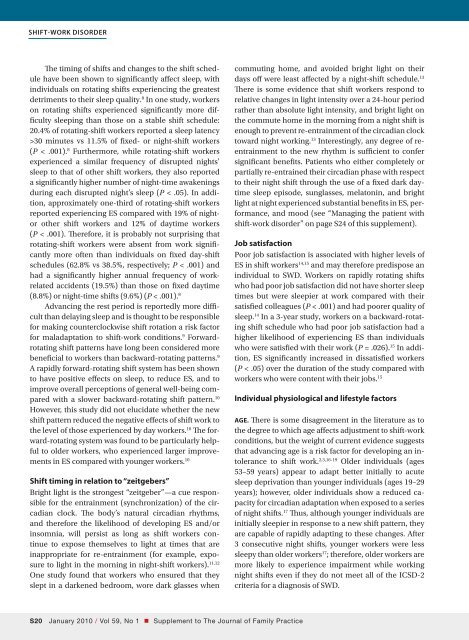The International - myCME.com
The International - myCME.com
The International - myCME.com
Create successful ePaper yourself
Turn your PDF publications into a flip-book with our unique Google optimized e-Paper software.
Shift-work disorder<br />
<strong>The</strong> timing of shifts and changes to the shift schedule<br />
have been shown to significantly affect sleep, with<br />
individuals on rotating shifts experiencing the greatest<br />
detriments to their sleep quality. 8 In one study, workers<br />
on rotating shifts experienced significantly more difficulty<br />
sleeping than those on a stable shift schedule:<br />
20.4% of rotating-shift workers reported a sleep latency<br />
>30 minutes vs 11.5% of fixed- or night-shift workers<br />
(P < .001). 8 Furthermore, while rotating-shift workers<br />
experienced a similar frequency of disrupted nights’<br />
sleep to that of other shift workers, they also reported<br />
a significantly higher number of night-time awakenings<br />
during each disrupted night’s sleep (P < .05). In addition,<br />
approximately one-third of rotating-shift workers<br />
reported experiencing ES <strong>com</strong>pared with 19% of nightor<br />
other shift workers and 12% of daytime workers<br />
(P < .001). <strong>The</strong>refore, it is probably not surprising that<br />
rotating-shift workers were absent from work significantly<br />
more often than individuals on fixed day-shift<br />
schedules (62.8% vs 38.5%, respectively; P < .001) and<br />
had a significantly higher annual frequency of workrelated<br />
accidents (19.5%) than those on fixed daytime<br />
(8.8%) or night-time shifts (9.6%) (P < .001). 8<br />
Advancing the rest period is reportedly more difficult<br />
than delaying sleep and is thought to be responsible<br />
for making counterclockwise shift rotation a risk factor<br />
for maladaptation to shift-work conditions. 9 Forwardrotating<br />
shift patterns have long been considered more<br />
beneficial to workers than backward-rotating patterns. 9<br />
A rapidly forward-rotating shift system has been shown<br />
to have positive effects on sleep, to reduce ES, and to<br />
improve overall perceptions of general well-being <strong>com</strong>pared<br />
with a slower backward-rotating shift pattern. 10<br />
However, this study did not elucidate whether the new<br />
shift pattern reduced the negative effects of shift work to<br />
the level of those experienced by day workers. 10 <strong>The</strong> forward-rotating<br />
system was found to be particularly helpful<br />
to older workers, who experienced larger improvements<br />
in ES <strong>com</strong>pared with younger workers. 10<br />
Shift timing in relation to “zeitgebers”<br />
Bright light is the strongest “zeitgeber”—a cue responsible<br />
for the entrainment (synchronization) of the circadian<br />
clock. <strong>The</strong> body’s natural circadian rhythms,<br />
and therefore the likelihood of developing ES and/or<br />
insomnia, will persist as long as shift workers continue<br />
to expose themselves to light at times that are<br />
inappropriate for re-entrainment (for example, exposure<br />
to light in the morning in night-shift workers). 11,12<br />
One study found that workers who ensured that they<br />
slept in a darkened bedroom, wore dark glasses when<br />
<strong>com</strong>muting home, and avoided bright light on their<br />
days off were least affected by a night-shift schedule. 13<br />
<strong>The</strong>re is some evidence that shift workers respond to<br />
relative changes in light intensity over a 24-hour period<br />
rather than absolute light intensity, and bright light on<br />
the <strong>com</strong>mute home in the morning from a night shift is<br />
enough to prevent re-entrainment of the circadian clock<br />
toward night working. 13 Interestingly, any degree of reentrainment<br />
to the new rhythm is sufficient to confer<br />
significant benefits. Patients who either <strong>com</strong>pletely or<br />
partially re-entrained their circadian phase with respect<br />
to their night shift through the use of a fixed dark daytime<br />
sleep episode, sunglasses, melatonin, and bright<br />
light at night experienced substantial benefits in ES, performance,<br />
and mood (see “Managing the patient with<br />
shift-work disorder” on page S24 of this supplement).<br />
Job satisfaction<br />
Poor job satisfaction is associated with higher levels of<br />
ES in shift workers 14,15 and may therefore predispose an<br />
individual to SWD. Workers on rapidly rotating shifts<br />
who had poor job satisfaction did not have shorter sleep<br />
times but were sleepier at work <strong>com</strong>pared with their<br />
satisfied colleagues (P < .001) and had poorer quality of<br />
sleep. 14 In a 3-year study, workers on a backward-rotating<br />
shift schedule who had poor job satisfaction had a<br />
higher likelihood of experiencing ES than individuals<br />
who were satisfied with their work (P = .026). 15 In addition,<br />
ES significantly increased in dissatisfied workers<br />
(P < .05) over the duration of the study <strong>com</strong>pared with<br />
workers who were content with their jobs. 15<br />
Individual physiological and lifestyle factors<br />
Age. <strong>The</strong>re is some disagreement in the literature as to<br />
the degree to which age affects adjustment to shift-work<br />
conditions, but the weight of current evidence suggests<br />
that advancing age is a risk factor for developing an intolerance<br />
to shift work. 2,3,16-19 Older individuals (ages<br />
53–59 years) appear to adapt better initially to acute<br />
sleep deprivation than younger individuals (ages 19–29<br />
years); however, older individuals show a reduced capacity<br />
for circadian adaptation when exposed to a series<br />
of night shifts. 17 Thus, although younger individuals are<br />
initially sleepier in response to a new shift pattern, they<br />
are capable of rapidly adapting to these changes. After<br />
3 consecutive night shifts, younger workers were less<br />
sleepy than older workers 17 ; therefore, older workers are<br />
more likely to experience impairment while working<br />
night shifts even if they do not meet all of the ICSD-2<br />
criteria for a diagnosis of SWD.<br />
S20 January 2010 / Vol 59, No 1 • Supplement to <strong>The</strong> Journal of Family Practice
















